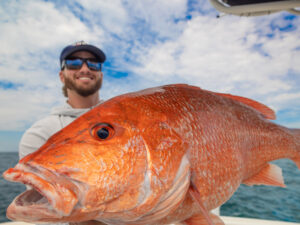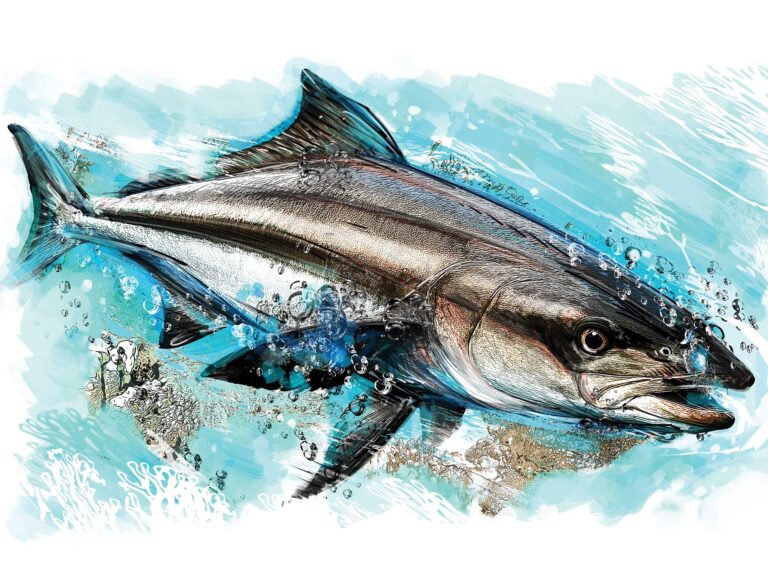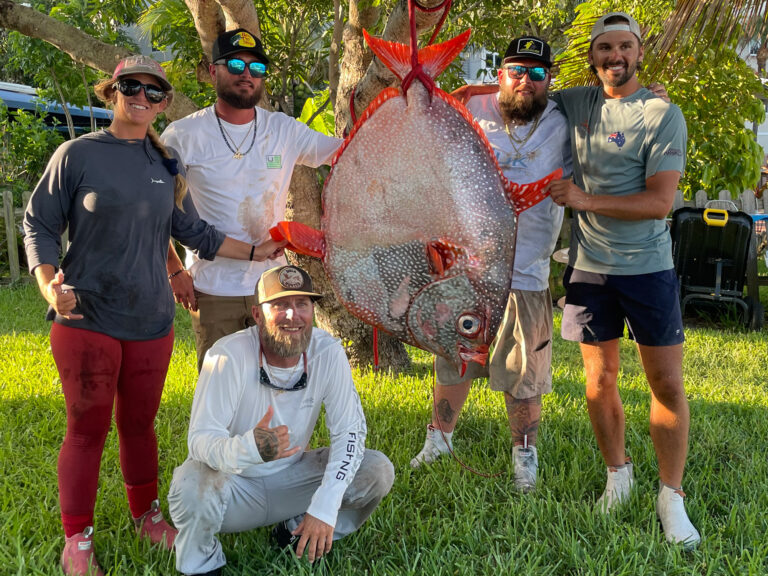
First, apologies for insulting you by citing the terribly cliched “elephants eat peanuts” maxim. But when it comes to fishing tiny lures, there’s really no getting around it. That catch-phrase is and has long been a ubiquitous part of fishermen’s jargon for a reason. It’s true. So often a fish larger than the angler ever imagined ends up hooked on a very small lure.
But then there is some logic to such experiences. We, as people, can say no thanks to something like liverwurst, but fish more often can’t afford to pass up anything edible they find, whether it’s a mouthful or a speck. So, yeah, “specks” do attract the attention of predators. And tiny lures put your offering on the menu of a great range of eaters from mini to mighty, increasing the odds for action.
Micro Fishing is Not Micro-Lure Fishing

Before we get too far along, I should stress that we’re talking about the growing specialized technique of micro-lure fishing and not a different approach, that of micro fishing. Micro fishing is a specific attempt to catch tiny fish, often less than the length of a finger — on hook and line, with line being 2-pound test or less, essentially no larger than sewing thread. The hooks used are called “hair hooks,” so named because they’re about as thick in diameter as a human hair.
Micro fishing is something my friend Steve Wozniak (no, not the one from Apple) of California practices regularly, with great success, as he approaches catching an astounding 2,000 fish species on hook and line, per his 1000-fish blog. Not that all of Wozniak’s catches are tiny; many are “macro” — of trophy size. But when he pursues fish the size of a cockroach, he’s micro fishing.
Small Lures Catch Large Fish

When anglers engage in micro-lure fishing, they’re ready for anything from fish as long as their hand to fish as long as their arm. While there’s no accepted standard that quantifies a lure as micro in size, think two inches, give or take. This may include Lilliputian crankbaits — actually far smaller than Jonathan Swift’s tiny folks from Lilliput. Crankbaits can be less than 1½ inches and weigh under 1/8 of an ounce. Most often, micro-lure anglers pair soft plastic tails, only a bit larger than your average mealworm, to thin-diameter hooks on jig heads that weigh 1/8 of an ounce or less.
Part and parcel of micro-lure fishing is ultra-light rods and reels. To go heavier would be more exasperating than fun. Think of trying to cast a Wooly Bugger trout fly on a baitcaster. But with scaled-down ultra-light spinners, spooled with 4- to 6-pound braided line, and thin, noodle-like rods, suddenly reasonably long casts aren’t out of reach.
Such super-light rods and reel also make micro-lure fishing feasible because they’re simply too light to apply great pressure — the sort of pressure that could easily bend out little micro hooks. Finesse is the key to all aspects of micro-lure fishing. Hook a (relatively) big one, and you’ll realize that you need all your skills as an angler to land that fish.
A Micro-Lure Fishing Day to Remember
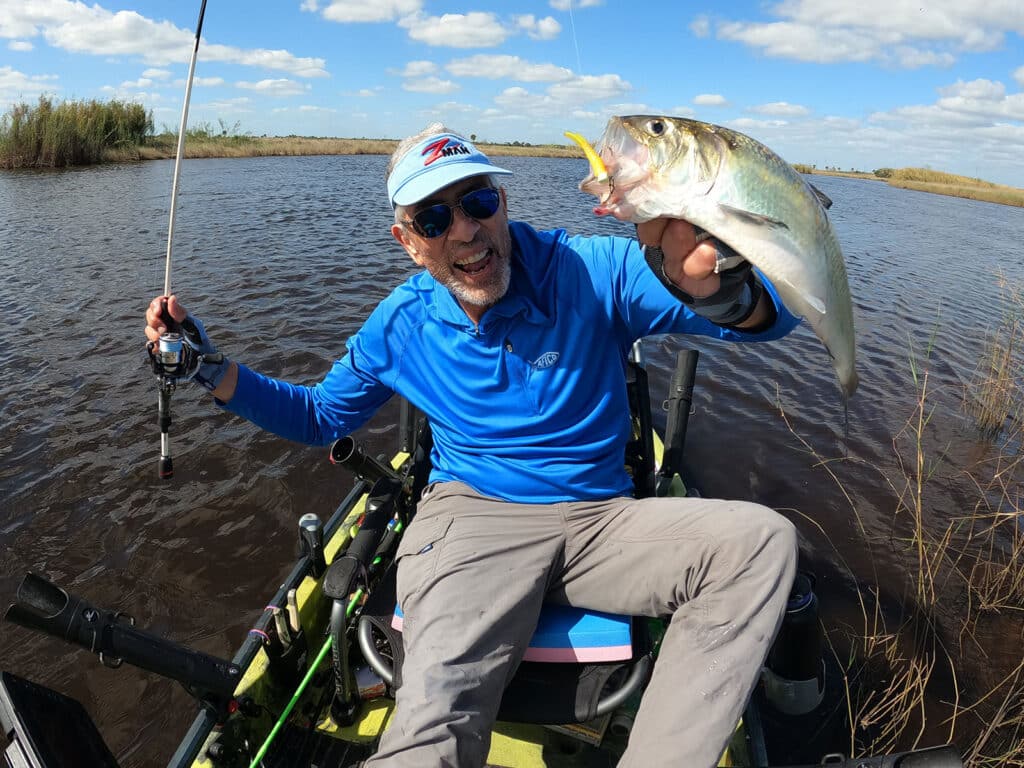
A recent morning fishing the St. Johns River in a shallow stretch northeast of Orlando, Florida, served as a good reminder to me just how rewarding micro-lure fishing can be. Variously casting and trolling 1/10-ounce mushroom jigheads, armed with 1 ½-inch soft baits, my first fish was a stunningly brilliant red-breasted sunfish. I would catch two more that morning. I was trolling up-current when my little rod arced under the sudden strain of what proved to be a lively American shad, the first of three I hooked on my tiny lures. After that I landed several crappie (including a sizable one for the river) and Mayan cichlids.

But the least expected catch on the teeny-tiny jig, and most impressive, came as I trolled mid-river when something far bigger than expected began heading downriver with me in tow. After a number of long, hard runs, I finally managed to get the fish by the kayak long enough to get my lip gripper on the lower jaw of a catfish weighing more than eight pounds. At times, I had felt pretty outgunned, attached to the fish with only 6-pound line and that tiny jig hook, but landing it made my day.
Tips from Micro-Lure Fishing Experts
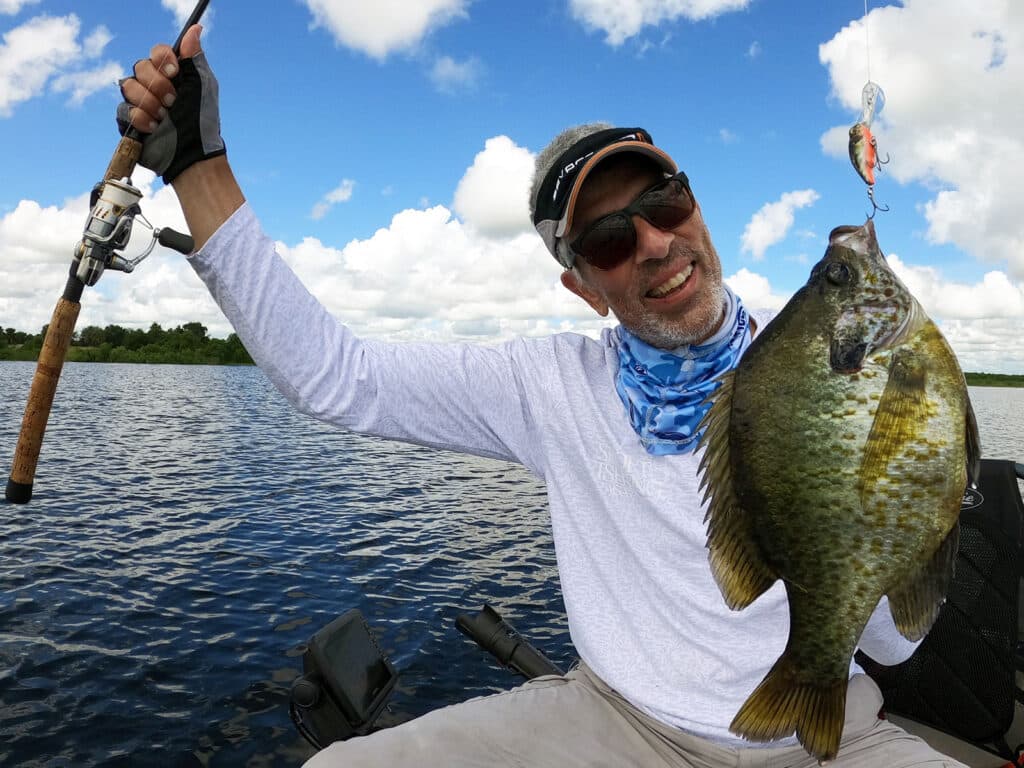
I asked two veteran micro-lure-fishing pros for their insight on this very specialized form of fishing. Paul Macinnis, an enthusiast fishing journalist, when not tied up in his day job as a Lockheed engineer, says he started fishing micro crankbaits in his youth, with Rapala Original Floating Minnows as small as 1.5 inches. “I’ve caught thousands of fish on that Original minnow and still use it. But Macinnis also favors the deeper-diving 1.5-inch Rapala Ultra Light Shad and the 1.5-inch Ultra Light Rippin’ Rap, a lipless rattler. “I catch a surprising number of monster bluegills on those two crankbaits,” he says.
For micro-lure expert Jose Chavez, a Florida resident of Tampa, his choice of micro lure is a tiny jighead with plastic tail, also in the 1.5-inch range. He fishes these, well — wherever he fishes, from home waters to as far away as Australia, where the micro jig-and-tails gave the kayak enthusiast an edge at times during a Hobie fishing tournament.
As for reels, both use 1000-size reels for much of their micro-lure fishing, though Chavez says he’ll go up to a 1500 size at times; Macinnis, on the other hand, will fish as light as a 500 size. He favors a 6-foot ultra-light rod (rated 2- to 6-pound); Chavez prefers slightly longer rods with light or medium-light power. That means rods with a decidedly soft action appropriate to very light lures and lines. Chavez goes with 10-pound braid, while Macinnis seldom exceeds six. Both prefer light leader — 10-pound test or lighter. Macinnis will tie his main line to 20-pound leader if tarpon, snook or large ladyfish are on hand.
“The Z-Man Shad Fry is my go-to lure,” says Chavez. “I use this 90 percent of the time,” he says of the 1.75-inch tail. Disclaimer here: Chavez is Z-Man’s Director of Product Development. That said, I am a fan of Z-Man’s squishy and super-tough ElaZtech soft lures, and have had success with the company’s entire Micro Finesse line of tiny soft baits (five designs), fished on their miniscule Micro Finesse Shroomz mushroom jig heads.

Macinnis also lists these as among his current faves, particularly the Tiny TicklerZ, StingerZ and Shad FryZ, but also Nikko’s medium Okiami Shrimp, 1.5-inch Caddisfly, and 1.9-inch Pin Straight worms.
Micro jigs and tails have a cost advantage. That is, they’re cheap, especially compared to larger such baits and other lures. So you can fill a box with a variety of little jig heads and soft tails without any great investment.
Tiny crankbaits aren’t quite as inexpensive, but their size still offers a cost saving. Most lure manufacturers do offer various versions of their popular crankbaits in 1.5- to 2.5-inch sizes. I’ve had some notable success with little divers such as Rapala’s Ultra-Light Crank and the Savage Gear 3D Goby Crank Bait, which sadly seems to be discontinued.
I tend to favor tiny deep divers like these in many situations, since their diminutive size limits how far they can dive but the large lip (relative to the lure) give the lure plenty of frenetic action in a hard jerk/pause retrieve. Macinnis says he’s also a fan of trolling tiny crankbaits when moving from spot to spot.
When to Fish With Micro Lures

For me, fishing micro lures offers two of the things I crave most when I go fishing: variety and action. Just about everything eats the flashy little lures, which means in many situations, it’s hard to predict what will end up on your lure next. And since just about everything will snap at a micro lure, figure on fast fishing oftentimes.
Chavez echoes the variety appeal. And he’s quick to break out his box of micros “when small forage is abundant in a waterway,” where “predators can become focused on small forage to the point they may ignore anything larger.” For Macinnis, micros are great “when I just want to catch a mess of fish, and not spend a lot of time, effort or money doing it.”
“Just about every body of water is home to minnows, insects, tiny shrimp and other small prey — and an array of fish that feed on them That means micro lures work just about anywhere,” says Macinnis. He has a great time fishing Florida retention ponds, creeks and roadside canals with micro lures for bluegill, sunfish, crappie, cichlids, bass, catfish and more. “Besides all those panfish, you may catch baby versions of much larger game fish, and sometimes weird little fish you never thought would be there.”

Fishing brackish water, as Macinnis often does, offers even more variety. And he mentions in particular how effective micro lures have proven for him many times when targeting baby tarpon, which are a real kick on light tackle. “They’re so tuned in to mosquitofish and little killifish, they’ll pounce all over micro lures while ignoring larger baits.” (Though bigger tarpon will also inhale mini baits: Macinnis recalls casting teeny jigs in a coastal pond and catching bluegill and shellcracker. “I had no idea tarpon were in that pond until a 15-pounder ate my micro jig. The hook grabbed in a perfect spot, and I eventually landed it.”)
In serious bass-fishing circles, micro baits have found fans. In clear waters or where fish populations are heavily pressured, bass — and not just little ones — that ignore big worms or lures often pick up micro lures without a second thought. Even coastally, in various fisheries, micro lures may prove valuable — for example at times for flounder.
The Challenges of Micro Fishing Lures

Fishing with such tiny offerings does present certain challenges. Both Macinnis and Chavez cite the casting distance of micro lures weighing as a limitation. Tossing lures weighing a fraction of an ounce can be tough, especially when it’s not with the wind. But very lightweight gear helps greatly. Chavez advises anglers not to bother fishing micro lures if they don’t have such light rods and reels. He likens trying to cast micros on heavier gear to “using a golf club to move a bowling ball.”
Tying braid to leader can be a challenge in general, but particularly with a very thin mainline to a wispy mono or fluoro leader. Macinnis extols the FG knot for this, and I’ve been able to tie some solid bobbin knots on super-light braid and leader, but when on the water, I still find it’s hard to beat tying a Bimini in the main line then tying that to the leader via an improved Bristol knot.
Tiny mushroom jigs have very small, thin hooks. The good news is that such hooks tend to bite into flesh without great pressure. The bad news is the danger of thin-wire hooks bending out. That’s where the super-light line and gear come in, along with an angler’s finesse skills, to avoid applying excessive pressure. Odds are if the very light line or leader don’t snap, the hook won’t bend out. But there’s no denying that an angler’s chances of landing bigger fish require a dose of luck as well. But that challenge is part of the micro-lure fun, says Macinnis.
Micro-Lure Fishing Tips

- You may find that it doesn’t take long before tiny soft tails keep sliding down the tiny hook. The fix, advises Macinnis: A dab of gel Super Glue to hold plastic tight to jig head.
- While he generally fishes one micro jig at a time, Macinnis says in open water where casting distance may be more important, he’ll switch to a tandem rig. Two jigs cast better than one, plus of course that does put a second lure in the water. It can also be a good way to test for color preference.
- Like Macinnis, Chavez cites juvie tarpon as a poster fish for the use of micro jigs. They’re often feeding on fry bait and glass minnows and, at such times Chavez is glad he has the gear and baits to offer up micros, because, “They won’t touch anything bigger. In this situation, which I often run into in my home waters, a micro-finesse plastic bait can change a morning of frustration into one of great fun!”

